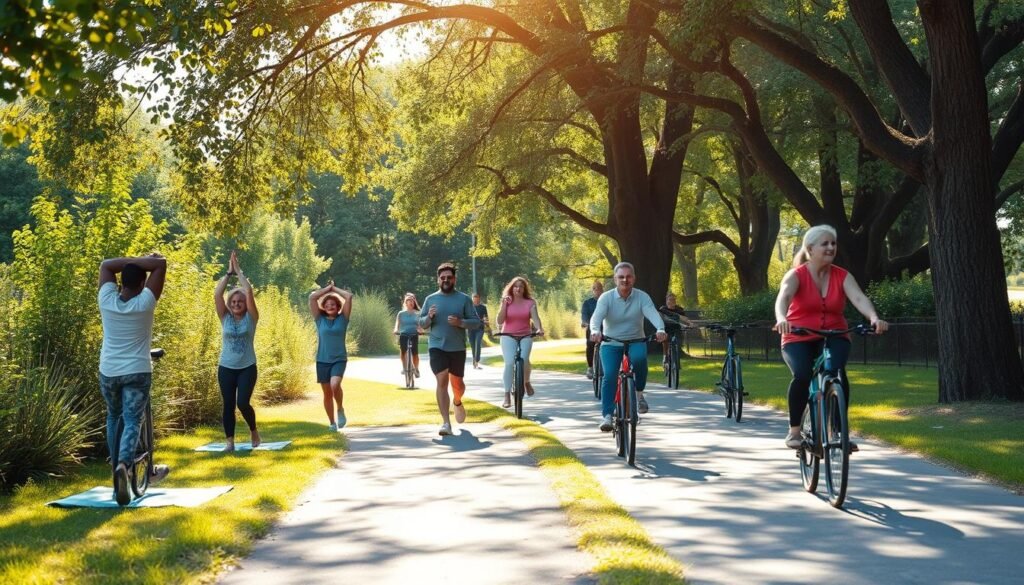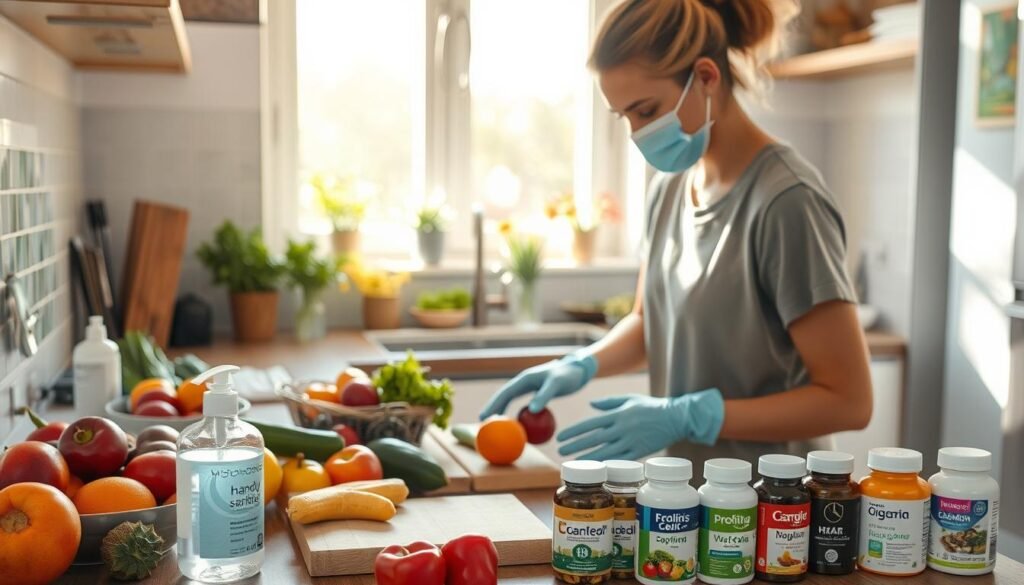Did you know over 81% of COVID-19 deaths are in people older than 65? This fact shows the need for special health advice for those at risk. If you are high-risk, like older folks or those with certain health conditions, it is crucial to take steps to stay healthy. By following expert advice, high-risk individuals can lower their risk of serious sickness and improve their health.
For high-risk people, staying healthy means knowing their risks and taking action to prevent illness. They can feel more in control of their health and guard against threats. With commitment, high-risk individuals can maintain their health and well-being.
Key Takeaways
- Over 81% of COVID-19 deaths are among seniors over 65 years old.
- High-risk groups include those with chronic diseases, obesity, and immunocompromised conditions.
- Staying active is crucial for maintaining health and lowering risks.
- Vaccination significantly reduces the chances of severe illness from COVID-19.
- Preventive measures like handwashing and mask-wearing are vital for high-risk individuals.
- Creating a support system can help high-risk individuals manage their health more effectively.
- Routine health checkups play a key role in early detection and prevention of complications.
The Importance of Vaccination for High-Risk Individuals
Vaccination is key in protecting those at high risk from serious diseases, like COVID-19. This includes people with weaker immune systems. They are more likely to get very sick, which could lead to needing hospital care or even cause death.
Anyone 6 months or older in high-risk groups should get two doses of the COVID-19 vaccine for 2024–2025. These doses should be given six months apart. The vaccine type might change depending on age and vaccine history.
Kids 6 months to 4 years old need two doses of the same vaccine. Older children, from 5 to 11 and those 12 and up, have more choices in vaccine brands.
High-risk people might need more than the first vaccines. Those with weaker immune systems, especially if it’s been over two months since their last shot, may need extra doses. If you recently had COVID-19, you might wait three months to get vaccinated. Always talk to your doctor about what’s best for you.
Getting a flu shot is also crucial. Almost 90% of people hospitalized for the flu had a health condition. Staying up to date with vaccines can protect against flu and COVID-19. This not only keeps you safe but helps the whole community by building immunity.
Understanding High-Risk Populations
High-risk populations are people with certain health conditions that make them more likely to get very sick. They might have diabetes, heart problems, obesity, or breathing issues. Older adults also face more risks because of their age. Knowing about these groups helps healthcare workers give better advice and prevent diseases. They can take care of health dangers more wisely.
Also, refugees have their own set of problems. More than half of all refugees are kids. Women and girls are half of these populations, facing more challenges. They need special care and guidelines to help them properly.
LGBTQI+ folks also deal with discrimination which can make their health worse. This is especially true where people don’t accept them. It’s important to include their experiences in healthcare to help everyone fairly.
| Population Group | Health Risks | Specific Challenges |
|---|---|---|
| Elderly | Chronic diseases, weakened immune system | Access to services, mobility issues |
| Children (under 18) | Developmental disorders, obesity | Access to healthcare, mental health support |
| Refugees | Trauma, infectious diseases | Language barriers, legal status |
| LGBTQI+ | Mental health issues, substance abuse | Discrimination, social ostracism |
It’s key to see the differences in high-risk groups for better health plans. Health experts can manage risks better with a clear view of everyone’s needs.
Guidelines for High-Risk Individuals
People at high risk need special care to keep their health in check. It’s key to know which situations up their health dangers. This knowledge leads to health recommendations for high-risk individuals that are just right.
Knowing these risks means we can figure out the best plans. These plans reduce dangers from diseases, even COVID-19.
Specific Conditions That Increase Health Risks
Certain health issues make people more prone to getting really sick. High-risk folks should know these issues:
- Those 65 and up are most likely to get very ill from COVID-19 if they haven’t been vaccinated.
- Having a weak immune system greatly increases the chance of serious illness.
- Conditions like heart disease and diabetes make people more vulnerable.
- Those with a family history of certain cancers should get checked earlier and more often.
Identifying Vulnerable Populations
Finding out who’s most vulnerable is crucial. This helps in giving them the right guidelines for high-risk individuals. With this, health care that fits their needs can be given:
- People in group living situations face higher risks because they are close to others.
- Racial and ethnic minorities might face health care barriers.
- Those with disabilities may need special health care approaches.
Using high-risk health tips helps keep people safe from many sicknesses. Being aware and following health advice leads to better well-being for those at high risk.
| Condition | Risk Factor | Screening Recommendation |
|---|---|---|
| Aged 65 and older | High | Regular health assessments and vaccinations |
| Immunocompromised | High | Frequent monitoring and early treatment options |
| Chronic diseases | Varies | Individual health plans and screening based on specific conditions |
| Strong family history of colorectal cancer | Increased | Early screening before age 45; consult with a healthcare provider |
Staying Up to Date with COVID-19 Vaccines
People at high risk should keep up with COVID-19 vaccines for the best protection. Vaccines lower the chance of getting severely sick and hospitalized. This is crucial to managing health during the pandemic.
Vaccine Safety and Efficacy
Studies show that COVID-19 vaccines are safe and work well. They greatly reduce the risk of severe illness, hospitalization, and death. Pregnant folks should get vaccinated to lower complications risks.
Those who’ve had COVID-19 should talk to doctors about when to get vaccinated. Waiting around three months may offer better defense against new strains.
The Need for Booster Shots
Booster shots are now key for people at high risk, especially with new virus strains around. The CDC offers advice on when to get booster shots. The 2024-2025 vaccines are being made to target these strains.
Everyone 6 months and older should follow the latest vaccine guidance. This helps keep them safe against the virus.
Keeping up with COVID-19 vaccines matters for personal and community health. Talk to healthcare providers to make smart choices. This helps everyone stay healthier.
Nutrition Tips for Maintaining a Healthy Diet
People at higher risk improve a lot by eating balanced, nutritious foods. This supports their immune system and overall health. It’s key to eat whole foods like fruits, veggies, and lean meats. Cutting down on processed foods is also important for a healthy diet.
Choosing Nutritious Foods
Focusing on nutrition, choosing nutritious foods is crucial. Eating lots of fruits and veggies, at least five portions a day, is recommended. This includes:
- 80g for fresh, canned, or frozen produce
- 30g for dried fruit
Eating whole, nutrient-dense foods like whole grains and low-fat dairy is beneficial. Adding fish such as salmon twice a week gives you omega-3s. Men should keep saturated fat under 30g and women under 20g daily for heart health.
Avoiding Processed Foods
To get healthier, avoiding processed foods is smart. They often have bad additives and too much salt. Keeping fat under 30% of your total energy and salt under 6g a day fights hypertension.
Drinking 6 to 8 glasses of liquid daily and avoiding bad breakfast choices helps too. Enjoying low-fat versions of comfort foods lets you have fun without the risk.
| Food Group | Recommendations |
|---|---|
| Fruits and Vegetables | 5 portions daily; include fresh, frozen, and canned |
| Fish | At least 2 portions weekly, focus on oily fish |
| Saturated Fats | Limit to 30g (men), 20g (women) daily |
| Salt | No more than 6g daily |
Physical Activity Recommendations
Regular physical activity is crucial for everyone’s health, more so for those at high risk. Following physical activity advice helps them control their weight and boosts well-being. Being more active brings huge physical and mental health benefits.
Benefits of Regular Exercise
Regular exercise offers more than just fitness improvements. It significantly reduces the risk of major illnesses for people at high risk. These include heart disease, stroke, and diabetes. Doing things that make your heart work harder strengthens it.
It also betters blood flow and lifts your spirits by releasing endorphins. Even moderate exercises like fast walking or water aerobics are great for your health. They push adult individuals to embed such activities in their day. Aim for 150 minutes of moderate exercise a week, but more is even better.
Strategies to Stay Active
To enhance physical activity levels, try these tips:
- Set achievable fitness targets and monitor your achievements.
- Make daily routines fun with activities like dancing, gardening, or biking.
- Get your friends, family, or workout groups involved for support.
Encouraging routine fun activities leads to steady habits. This results in lasting health improvements. Including these physical activity suggestions for those at high risk can change lives for the better.

Preventive Health Care Checkups
Regular checkups are key for high-risk people’s health. These exams help find health problems early, leading to better care. Knowing the importance of routine screenings improves overall health and life quality for those at risk.
Importance of Routine Screenings
Early detection of chronic conditions is crucial through routine screenings. Some conditions, like high blood pressure, might not show symptoms. Regular checkups reveal these hidden risks, enabling early treatment.
Scheduled Health Exams Based on Age and Risk Factors
Screening needs vary by age and health conditions. Those at high risk should follow specific exam schedules. Below is a table showing important screenings for different groups:
| Screening | Recommended Age Group | Frequency |
|---|---|---|
| Abdominal Aortic Aneurysm | Men aged 65-75 who have smoked | 1-time |
| Anxiety Disorders | Adults 64 years or younger | As needed |
| Aspirin for Preeclampsia Prevention | Pregnant persons at high risk | As recommended |
| Breast Cancer | Women aged 40-74 | Every 2 years |
| Colorectal Cancer | Adults aged 45-49, 50-75 | As recommended |
| Depression Screening | Adults, pregnant individuals | As needed |
| Falls Prevention | Adults aged 65 and older | Exercise interventions |
| Hepatitis B Virus | Adolescents, adults, pregnant women | As needed |
| Lung Cancer | Adults aged 50-80 with a 20 pack-year smoking history | Annually |
| Hypertension | Adults 18 years or older | As needed |
Talking to healthcare providers often is crucial. It ensures you get the right screenings. Preventive care is vital for long-term health and preventing diseases.
Managing Stress and Mental Health
Mental health is key to overall well-being, especially for those at high risk. These individuals often face more stress. This can come from pandemics, natural disasters, or violence. It’s important to see how this stress affects our bodies.
Chronic stress can lead to sleep problems, weakened immunity, and heart issues. Knowing this can help us tackle stress better.
Recognizing the Impact on Physical Health
Stress can cause headaches, high blood pressure, and trouble sleeping. Sometimes anxiety sticks around even when there’s no clear danger. That’s why it’s crucial for those at risk to focus on managing stress.
This can help avoid mental health issues like anxiety and depression. Recognizing stress symptoms like worry and tension is the first step. This helps us deal with stress early on.
Using good coping strategies can make a big difference in mental health. Techniques like writing in a journal, relaxing, and exercising help. Seeking support through therapy, friends, and community resources is also key.
Don’t forget about eating right. A balanced diet supports both mental and physical health.
| Stress Impact | Associated Health Problems | Coping Techniques |
|---|---|---|
| Physical symptoms (e.g., headaches) | Heart disease, digestive issues | Journaling, relaxation exercises |
| Sleep disturbances | Weakened immune response | Regular exercise, social support |
| Anxiety and excessive worry | Reproductive health concerns | Mindfulness meditation, healthy eating |

Substance Use and Its Effects on Health
Substance use greatly affects the health of many, especially those at high risk. It is vital to understand how drugs and alcohol affect health. For high-risk people, managing substance use is key to avoid bad health effects. Quitting smoking and drinking less alcohol are big steps toward better health.
Quitting Smoking and Reducing Alcohol Intake
A look at the numbers shows why we need to act. For example, 15% of high schoolers have tried illegal drugs, and 14% misused painkillers. Most people with substance problems started in their teens or early twenties. Programs to help quit smoking and drink less could change this trend.
Studies show certain things can help lower drug use in kids. Having involved parents and feeling connected at school can keep kids from trying drugs. On the flip side, not enough parental guidance and hanging out with the wrong crowd can increase risk. Programs focusing on these areas can make communities safer.
Aside from immediate health issues, long-term substance use can cause major problems like heart issues, breathing troubles, and cancer risks. The CDC’s Teens Linked to Care project shows how special efforts in rural areas can help prevent drug use among young people.
Stopping smoking and drinking less isn’t just good for you personally. It helps everyone by leading to major public health improvements. Better strategies for dealing with substance use can save many lives. For more on how smoking affects health and tips on quitting, check out this health guide.
Safe Practices in Daily Life
For high-risk individuals, it’s crucial to adopt safe practices daily. This protects their health, especially amid COVID-19. Focusing on hygiene and mask-wearing shields them from many illnesses.
Hygiene and Mask Wearing
High-risk people should wash their hands regularly. They should also use alcohol-based hand sanitizers. These steps help stop the spread of germs.
In crowded places, wearing a mask is an added defense. This practice greatly reduces the chance of getting COVID-19. It’s especially important for those at greater health risk.
It’s also key to stay updated on respiratory viruses. The CDC gives weekly health updates. Home COVID-19 test kits help make informed health decisions. Knowing when to get treatment lowers the risk of serious illness.

Traveling with a friend and being alert boosts safety. This increases confidence in public areas. Responding to danger quickly improves overall well-being. These practices help high-risk people live healthier, safer lives.
Creating a Support System
Setting up a support network is vital for people at high risk. It provides emotional, physical, and practical help. This makes dealing with challenges easier. Having a strong circle also builds resilience, especially under stress. It shows why including family and friends in health care is key.
Engaging Family and Friends
Getting family and friends involved improves health outcomes. It creates a sense of accountability and boosts motivation. These relationships are crucial for keeping up with healthy living. A 2022 study found that social support helps people bounce back during tough times. It acts as a protective barrier. Staying in touch, doing activities together, and offering emotional support can greatly improve someone’s mental and physical health.
Utilizing Community Resources
Support groups and health organizations provide vital support to those at risk. They help people feel like they belong and fight off loneliness. This connection can stop loneliness from hurting one’s physical health. Using these resources also teaches people about crisis care and how to handle stress better. Finding support in the community can significantly improve someone’s life.
Conclusion
For people at high risk, their health can greatly improve by following detailed health advice. This conclusion for high-risk individuals’ health shows how special plans, support from the community, and following advice on vaccines, food, exercise, and preventive care are key. These steps can help manage risks and enhance health outcomes.
It’s also key to keep improving how health guidelines are created, used, and reviewed. Research points out that not enough quality evidence can make managing serious health issues hard. This shows how vital it is for health systems to fill these gaps. By using things like practice guidelines, people and their caregivers can make better health choices.
Working together is critical in the successful use of health guidelines. Different groups like health care pros, advocacy groups, and community services must join forces. Only by working together can we create a full plan that leads to better health for people at high risk. This is the main point in this detailed summary of health guidelines.